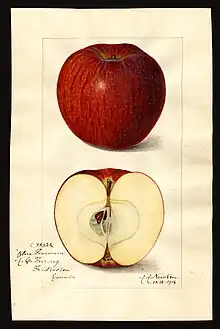Blue Pearmain
The 'Blue Pearmain' is an American apple variety, mentioned by Henry David Thoreau in his 1862 essay "Wild Apples."

History
The Blue Pearmain's origin is uncertain, but it was known in the US, and widely planted near Boston, in the early 1800s.[1][2]
Henry David Thoreau describes picking and eating "Blue-Pearmain" apples in his 1862 essay "Wild Apples."[3][4]
In the late 19th century, the Blue Pearmain won some recognition in England, receiving "an Award of Merit from the Royal Horticultural Society in 1893 and a First Class Certificate in 1896," according to the website of the United Kingdom's National Fruit Collection.
Characteristics
The apple is large, typically round, with a thick red skin stippled with dots and overlaid by the characteristic blue bloom that gives the variety its name.[2] According to Rowan Jacobson in his book Apples of Uncommon Character:[5]
..the look of the Blue Pearmain is half the pleasure. It starts in September as an impressionist’s masterpiece of swirling reds, oranges, and yellows, then, as fall goes by, it deepens into a dark burgundy with blackish streaks and a powdery blue bloom over the surface, as if night was falling and the last colors were draining from the sky.
Jacobson describes the Blue Pearmain's flavor as "all pear and melon and fig, with a touch of hard-charging kiwi brightness to keep things from getting cloying".[5] The apple can be used for fresh eating or for cider or baking. If stored for more than two months, the apples tend to shrivel.[6]
References
- "Blue Pearmain". UK National Fruit collection. Retrieved July 9, 2023.
Thought to have originated in U.S.A. It was known in the early 1800s. Received an Award of Merit from the Royal Horticultural Society in 1893 and a First Class Certificate in 1896. Fruits have somewhat dry, rather soft, coarse-textured flesh with a sweet, pleasant aromatic flavour.
- Beach, Spencer Ambrose (1903). "The Apples of New York, Volume 1" (PDF). New York (State). Dept. of Agriculture, New York State Agricultural Experiment Station. Retrieved July 9, 2023.
The fruit is of mild flavor and does not rank high in quality. The skin is thick. When well colored it is beautiful, though not brilliant, being overcast with a dull bluish bloom. In common storage it does not keep late, and by January it often becomes shriveled (18). It is not a good market fruit and is not recommended for commercial planting
- "Thoreau's Apples at Gaining Ground". Thoreau Farm. May 22, 2012. Retrieved July 9, 2023.
"For I do not refuse the Blue-Pearmain, I fill my pockets on each side; and as I retrace my steps in the frosty eve, being perhaps four or five miles from home, I eat one first from this side, and then from that, to keep my balance.' -Thoreau, 'Wild Apples'
- Thoreau, Henry David. "Wild Apples". American Transcendentalism Web.
I know a Blue-Pearmain tree, growing within the edge of a swamp, almost as good as wild.
- Rowan Jacobson (2014). Apples of Uncommon Character. Bloomsbury USA. ISBN 9781632860354.
The Blue Pearmain is one of the classic old-timey New England apples. A taste of one will make you realize how threadbare our popular apples have become when it comes to interesting flavors.
- "Blue Pearmain". Pomiferous.
Cold Storage: Keeps up to two months in cold storage but tends to shrivel which gives the apple unappetizing appearance though the flavours become more concentrated and intense.